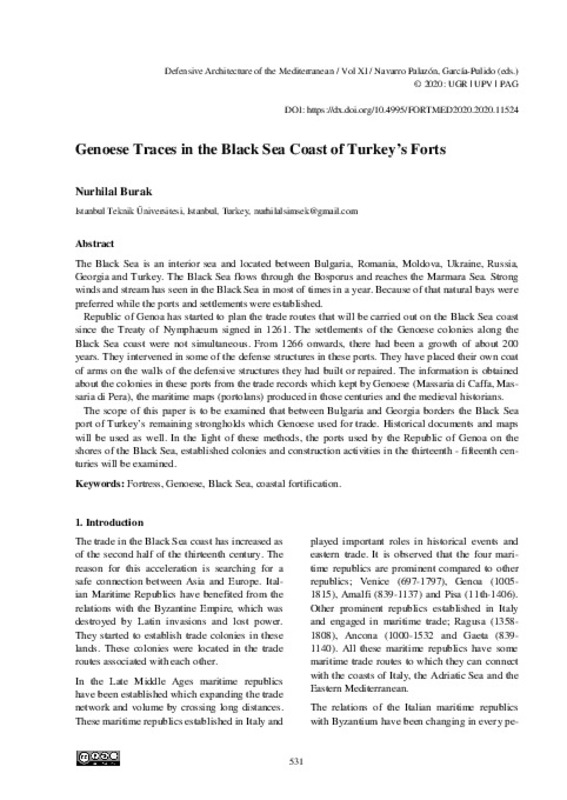JavaScript is disabled for your browser. Some features of this site may not work without it.
Buscar en RiuNet
Listar
Mi cuenta
Estadísticas
Ayuda RiuNet
Admin. UPV
Genoese Traces in the Black Sea Coast of Turkey’s Forts
Mostrar el registro sencillo del ítem
Ficheros en el ítem
| dc.contributor.author | Burak, Nurhilal
|
es_ES |
| dc.coverage.spatial | east=32.3853122; north=41.7499939; name=Kaleiçi, Kemere Sk. No:4, 74300 Amasra/Bartın, Turquia | es_ES |
| dc.date.accessioned | 2020-07-06T12:37:04Z | |
| dc.date.available | 2020-07-06T12:37:04Z | |
| dc.date.issued | 2020-05-15 | |
| dc.identifier.isbn | 9788490488560 | |
| dc.identifier.uri | http://hdl.handle.net/10251/147500 | |
| dc.description.abstract | [EN] The Black Sea is an interior sea and located between Bulgaria, Romania, Moldova, Ukraine, Russia, Georgia and Turkey. The Black Sea flows through the Bosporus and reaches the Marmara Sea. Strong winds and stream has seen in the Black Sea in most of times in a year. Because of that natural bays were preferred while the ports and settlements were established. Republic of Genoa has started to plan the trade routes that will be carried out on the Black Sea coast since the Treaty of Nymphaeum signed in 1261. The settlements of the Genoese colonies along the Black Sea coast were not simultaneous. From 1266 onwards, there had been a growth of about 200 years. They intervened in some of the defense structures in these ports. They have placed their own coat of arms on the walls of the defensive structures they had built or repaired. The information is obtained about the colonies in these ports from the trade records which kept by Genoese (Massaria di Caffa, Massaria di Pera), the maritime maps (portolans) produced in those centuries and the medieval historians. The scope of this paper is to be examined that between Bulgaria and Georgia borders the Black Sea port of Turkey’s remaining strongholds which Genoese used for trade. Historical documents and maps will be used as well. In the light of these methods, the ports used by the Republic of Genoa on the shores of the Black Sea, established colonies and construction activities in the thirteenth - fifteenth centuries will be examined. | es_ES |
| dc.language | Inglés | es_ES |
| dc.publisher | Editorial Universitat Politècnica de València | es_ES |
| dc.rights | Reconocimiento - No comercial - Sin obra derivada (by-nc-nd) | es_ES |
| dc.subject | Fortifications | es_ES |
| dc.subject | Mediterranean | es_ES |
| dc.subject | Modern age | es_ES |
| dc.subject | Built Heritage | es_ES |
| dc.subject | Fortress | es_ES |
| dc.subject | Genoese | es_ES |
| dc.subject | Black Sea | es_ES |
| dc.subject | Coastal fortification | es_ES |
| dc.title | Genoese Traces in the Black Sea Coast of Turkey’s Forts | es_ES |
| dc.type | Capítulo de libro | es_ES |
| dc.type | Comunicación en congreso | es_ES |
| dc.identifier.doi | 10.4995/FORTMED2020.2020.11524 | |
| dc.rights.accessRights | Abierto | es_ES |
| dc.description.bibliographicCitation | Burak, N. (2020). Genoese Traces in the Black Sea Coast of Turkey’s Forts. Editorial Universitat Politècnica de València. 531-536. https://doi.org/10.4995/FORTMED2020.2020.11524 | es_ES |
| dc.description.accrualMethod | OCS | es_ES |
| dc.relation.conferencename | FORTMED2020 - Defensive Architecture of the Mediterranean | es_ES |
| dc.relation.conferencedate | Octubre 01-03,2020 | es_ES |
| dc.relation.conferenceplace | Granada, Spain | es_ES |
| dc.relation.publisherversion | http://ocs.editorial.upv.es/index.php/FORTMED/FORTMED2020/paper/view/11524 | es_ES |
| dc.description.upvformatpinicio | 531 | es_ES |
| dc.description.upvformatpfin | 536 | es_ES |
| dc.type.version | info:eu-repo/semantics/publishedVersion | es_ES |
| dc.relation.pasarela | OCS\11524 | es_ES |








